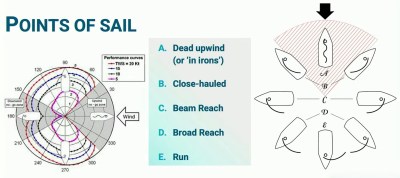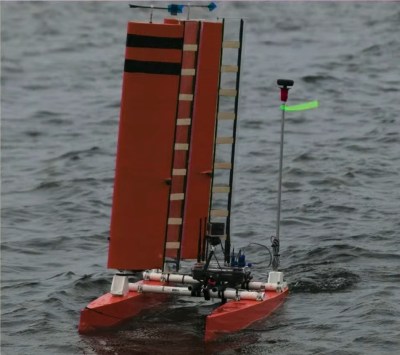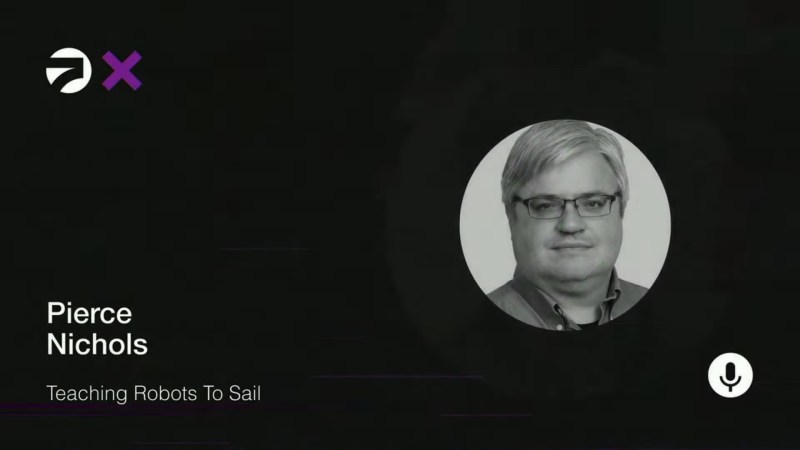Sailing the high seas with the wind conjures a romantic notion of grizzled sailors fending off pirates and sea monsters, but until the 1920s, wind-powered vessels were the primary way goods traveled the sea. The meager weather-prediction capabilities of the early 20th Century spelled the end of the sailing ship for most cargo, but cargo ships currently spend half of their operating budget on fuel. Between the costs and growing environmental concerns, [Pierce Nichols] thinks the time may be right for a return to sails.
[Nichols] grew up on a sailing vessel with his parents, and later worked in the aerospace industry designing rockets and aircraft control surfaces. Since sailing is predominantly an exercise in balancing the aerodynamic forces of the sails with the hydrodynamic forces acting on the keel, rudder, and hull of the boat, he’s the perfect man for the job.
While the first sails developed by humans were simple drag devices, sailors eventually developed airfoil sails that allow sailing in directions other than downwind. A polar diagram for a vessel gives you a useful chart of how fast it can go at a given angle to the wind. Sailing directly into the wind is also known as being “in irons” as it doesn’t get you anywhere, but most other angles are viable.
the first sails developed by humans were simple drag devices, sailors eventually developed airfoil sails that allow sailing in directions other than downwind. A polar diagram for a vessel gives you a useful chart of how fast it can go at a given angle to the wind. Sailing directly into the wind is also known as being “in irons” as it doesn’t get you anywhere, but most other angles are viable.
After a late night hackerspace conversation of how it would be cool to circumnavigate the globe with a robotic sailboat, [Nichols] assembled a team to move the project from “wouldn’t it be cool” to reality with the Pathfinder Prototype. Present at the talk, this small catamaran uses two wing sails to provide its primary propulsion. Wing sails, being a solid piece, are easier for computers to control since soft sails often exhibit strange boundary conditions where they stop responding to inputs as expected.
In its first iteration,  Pathfinder was controlled with Ardupilot and servos directly attached to the wing sails. For this application, [Nichols] and his team found that the program was unable to successfully navigate multiple points and was difficult to edit due to its monolithic nature. A rebuild of the boat with a new cellular modem instead of Wi-Fi, bigger batteries, and a power switch changed to PX4 for control. They found that using cross-tack error, or the deviation from a straight line between waypoints works well for confined waters with well-documented hazards, but in open water “best velocity made good” can be more efficient.
Pathfinder was controlled with Ardupilot and servos directly attached to the wing sails. For this application, [Nichols] and his team found that the program was unable to successfully navigate multiple points and was difficult to edit due to its monolithic nature. A rebuild of the boat with a new cellular modem instead of Wi-Fi, bigger batteries, and a power switch changed to PX4 for control. They found that using cross-tack error, or the deviation from a straight line between waypoints works well for confined waters with well-documented hazards, but in open water “best velocity made good” can be more efficient.
With some experience under their belt, the crew was able to secure funding to build a larger test vessel. With a cheap catamaran and 400 square feet of rental space, this vessel was equipped with two wing sails on one of the hulls and commenced testing in the Puget Sound. Keeping the wing sails on a single hull keeps the deck clear for cargo without significantly affecting performance.
Despite some setbacks, like breaking apart and sinking, the new vessel is yielding lots of interesting data which will lead to the first operating full-scale vessels. These will be designed to carry one or two ISO standard shipping containers to rural locations. Current regulations require a small crew aboard the boat, but [Nichols] hopes that the research they’ve been doing on autonomous vessel control will lead to fully autonomous trips in the future to help make deliveries to Alaska or other remote places more economical.
Further down the line, larger vessels will be able to handle hundreds or thousands of containers. Toward the end of the talk, [Nichols] gave us a list of resources for anyone interested in pursuing nautical hacks including many works by C.A. Marchaj or looking into the Amateur Yacht Research Society to “do weird things with sailboats.”















AIUI, sailing wessels are commonly used along the east coast of Africa extending to India.
Having grown up far from “big water” I find the numerous sailing terms in the article (I haven’t watched the video yet) interesting.
Most importantly you need to keep alert for a shout of ‘Ready about”, quickly followed by “lee ho!”, at which point you should duck down low to avoid being thrown over board by the boom.
If you read “The New New Thing”, Michael Lewis posits that the the nerdy & self-aggrandizing desire to build big robotic sailboats was what drove early Silicon Valley CEOs to take their companies public even if they weren’t profitable. I.E. Netscape’s CEO needed more money to build his enormous robotic sailboat, so he took his loss-making company public and ignited the tech bubble.
I don’t think much progress had been made since then though.
The progress has been in understanding, software, satellite data, weather prediction, battery tech, and dirt cheap commodity compute/control hardware with VASTLY more processing capability and power efficiency.
There is also a lot more pressure to make it happen. Economic pressure, which is the only reason an industry will ever do anything they aren’t forced to do.
Sometimes things take multiple tries to get going.
Other times they never work.
We’ll have to wait and see.
What was interesting about that era is that it wasn’t driven by economic pressure. It was a few multimillionaires driven by status and envy. They each wanted to personally own the “biggest sailboat in the world”. When they started to reach the realistic limits of size, they turned to building the “most automated sailboat in the world”. I don’t think there was any plan to commercialize or even share the technology.
https://en.wikipedia.org/wiki/Hyperion_(yacht)
They had generators and server racks in these yatchs so battery and CPU power weren’t the limitation. If I had to point to one thing that is different now, it’s aesthetics. The yatch automators limited themselves to traditional sail rigging because they wanted the ships to look pretty. A utilitarian approach can use simpler sails like the ones in the project above.
oh I think there’s been plenty of progress in autonomic sailboats. just not a lot of progress in tech CEO impulsive behavior 😂
I don’t think ‘early silicon valley’ means what you think it means.
Shockley, not Metcalf.
Your opinion on ‘progress’ is ignored.
Surely you don’t mean things like computers stabilizing sailing hydrofoils.
Rather repeating commie DERP that belongs on FARK or some equally ‘tarded site.
In the USA those claiming ‘progressive’ politics are reactionaries, who liked the politics of the 1930s.
Joe not Adolf.
Also in the USA: ‘liberals’ _hate_ liberty.
Words mean things.
Just not what they once meant.
Liberals don’t hate liberty.
They hate that a single person’s extreme personal liberty choices are allowed to override the “freedom” of the masses.
Liberals want to maximize overall liberty, even if that means any one person is “limited” to being no more free than the rest.
Limitations ENFORCE freedom, otherwise only the strong or lucky get to be free.
Enjoy your freedom to listen to all those conspiracy theory podcasts/crypto scams.
Argh! Booty sailing around without any mates on board. Hoist the jolly roger.
No crew, so it isn’t piracy, it’s salvage,eh? :)
Saildrone and NOAA have made some pretty nice trips with their craft. I’ve seen them, neat machines https://www.saildrone.com/tag/noaa
Heh. Sailing is what I do when I want a break from obsessing over technology. Ok yes there’s a lot of tech in even the simplest modern sailboat (and often a depth sounder, wind instrument, GPS, VHF radio), but still….sailing that sailboat, feeling the rudder pressure on the tiller in one hand, sheets (sail-controlling ropes) in the other, watching the course, the sail shapes, feeling the heel… it’s a near perfect example of flow, being in the moment, a somewhat physical activity that chases out pointless thought. 15 min of sailing feels like an hour, a good, cleansing hour.
So, this experience gives me an appreciation for the technological challenges in autonomous sailing, especially determining the optimum set of the sails. Cool project. Don’t automate our boat though, mkay? Thx.